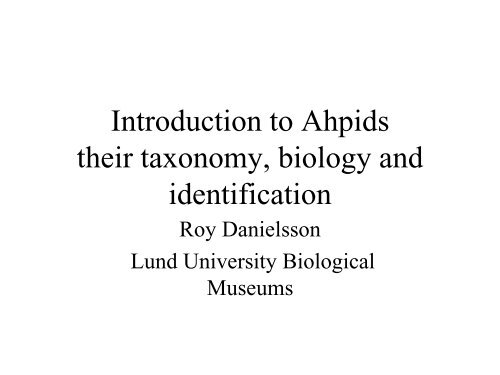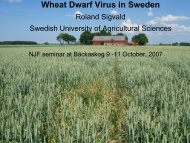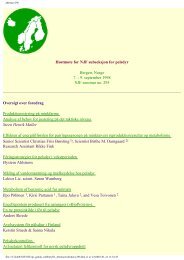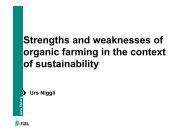Introduction to aphids.pdf - NJF
Introduction to aphids.pdf - NJF
Introduction to aphids.pdf - NJF
Create successful ePaper yourself
Turn your PDF publications into a flip-book with our unique Google optimized e-Paper software.
<strong>Introduction</strong> <strong>to</strong> Ahpids<br />
their taxonomy, biology and<br />
identification<br />
Roy Danielsson<br />
Lund University Biological<br />
Museums
• Geographical distribution<br />
• Aphid morphology<br />
• Aphid biology<br />
• Systematics
• 8000 aphid species described<br />
• 35 % synonymic names<br />
• 5000 valid names<br />
• 600 species known in Scandinavia
Aphid morphology
Aphid Biology<br />
• Cyclical parthenogenesis<br />
• Life-cycles<br />
• Polymorphism<br />
• Feading and seasonal variation<br />
• Survival strategies
Cyclical parthenogenesis<br />
• A complete life cycle consists of a generation of<br />
sexual morphs and two or more generations where<br />
only parthenogenetic females are produced.<br />
• In Adelgidae and Phylloxeridae, both sexual and<br />
parthenogenetic females are oviparous but in other<br />
families the parthenogenetic females give birth <strong>to</strong><br />
developed larvae ”viviparae” The sexual females<br />
are called ”oviparae”<br />
• ”Telescoping” parthenogenesis
Life cycles<br />
• The aphid life cycles can be devided in<strong>to</strong><br />
• 1. Holocyclical - the cycle starts and ends with an egg.<br />
• 2. Anholocyclical - a continuous production of parthenogenetic females<br />
where sexual reproduction never or very rarely occurs.<br />
• The life cycles can also be devived in<strong>to</strong><br />
• 1.Monoecious - no host alternation occurs<br />
• 2.Heteroecious - where a regular host alternation occurs
Aphid generations<br />
• Fundatrix (stem-mother) -First generation of parthenogenetic females<br />
which hatch from the over-wintering eggs. Usually apterous.<br />
• Fundatrigeniae - Subsequent generations of parthenogenetic females<br />
developing on the primary host. Apterous or alate<br />
• Alienicolae (Exules) - Generations of parthenogenetic females<br />
developing on the secondary host. Apterous or alate.<br />
• Sexuales - Males and oviparous females. Males can be apterous or alate.<br />
Oviparous females usually apterous.
Alate forms<br />
• Emigrants (spring migrants) - Winged parthenogenetic females developing on<br />
the primary host and fly <strong>to</strong> the secondary host.<br />
• Alate alienicolae - Winged parthenogenetic females developing on the secondary<br />
host and fly <strong>to</strong> the secondary host.<br />
• Immigrants (autumne migrants) - Winged parthenogenetic females developing<br />
on the secondary host and fly <strong>to</strong> the primary host.<br />
– Winged males<br />
– Gynoparae- larvae becomes oviparous females<br />
– Androparae- larvae becomes apterous males<br />
– Sexuparae- larvae becomes apterous males and oviparous females
Survival strategies<br />
• Living on root an stem succors<br />
• Shortened life cycles<br />
• Special diapause larvae<br />
• Not reproducing during summer<br />
• Migration <strong>to</strong> a secondary host
Related insect groups<br />
Hemiptera<br />
Homoptera Heteroptera<br />
Sternorrhyncha Auchenorrhyncha<br />
Coccoidea Aleurodoidea Psylloidea Aphidoidea
• Phylloxeroidea<br />
• Adelgidae<br />
• Phylloxeridae<br />
• Aphidoidea<br />
• Mindaridae<br />
• Hormaphididae<br />
• Phloeomyzidae<br />
• Thelaxidae<br />
• Anoeciidae<br />
• Pemphigidae<br />
• Drepanosiphidae<br />
• Greenideidae<br />
• Aphididae<br />
• Lachnidae<br />
Systematics
• 11 Species in Sweden<br />
Adelgidae<br />
• Living on coniferous trees<br />
• Both monophagous and host-alternating<br />
• 2 year life cycle
Adelges laricis
Adelges laricis
Adelges cooleyi
• 5 species in Sweden<br />
Phylloxeridae<br />
• Short, 3-jointed antennae<br />
• 2 species on Salix, 3 on Quercus<br />
• Monophagous<br />
• Grape phylloxera (Viteus vitifoliae)
Phylloxera on Quercus
Mindaridae<br />
• One genus in the family<br />
• 2 species in Sweden<br />
• Mindarus abietinus on Abies<br />
• Mindarus obliquus on Picea<br />
• Only 3 generation during the year
Mindarus abietinus
Balsam twig aphid
Hormaphididae<br />
• Only 1 species in Sweden<br />
• Main distribution in Asia<br />
• Many host-alternating species with Styrax<br />
as primary host.<br />
• Apterae on secondary host resembles a<br />
Coccid or Aleurodid
Hamamelistes betulinus
Hamamelistes spinosus<br />
Hormaphis hamamelidis
Pseudoregma alexanderi
Phloeomyzidae<br />
• Only 1 species, Phloeomyzus passerini<br />
living on trunks of Populus spp.<br />
• World-wide distribution<br />
• Not yet found in Scandinavia
Thelaxidae<br />
• Species on woody plants of Betulaceae,<br />
Fagaceae and Juglandaceae<br />
• 4 species in Sweden<br />
• Ant attended colonies
Thelaxes dryophila
Glyphina betulae
Anoeciidae<br />
• Two genera in the world<br />
• 6 species of Anoecia in Sweden<br />
• Primary host Cornus<br />
• Secondary hosts are grasses and sedges
Anoecia sp. På Cornus
Pemphigidae<br />
• Mainly host-alternating species<br />
• Galls and leaf-curling on primary hosts<br />
• Secondary generations on roots of woody<br />
plants and herbaceous plants<br />
• Anholocyclic hibernation on secondary host
• Eriosomatinae<br />
• Ulmaceae as primary host<br />
• Pemphiginae<br />
Pemphigidae<br />
• Populus, Fraxinus, Tilia, Crataegus, Lonicera a.o. as primary hosts<br />
• Fordinae<br />
• Pistacia as primary host
Eriosoma lanigera<br />
(Woolly apple aphid)
Eriosoma ulmi a.o.
Eriosoma ulmi
Eriosoma lanuginosum
Tetraneura ulmi
Colopha compressa
• Eriosomatinae<br />
• Ulmaceae as primary host<br />
• Pemphiginae<br />
Pemphigidae<br />
• Populus, Fraxinus, Tilia, Crataegus, Lonicera a.o. as primary hosts<br />
• Fordinae<br />
• Pistacia as primary host
Pemphigus bursarius
Pemphigus bursarius
Pemphigus passeki<br />
Pemphigus phenax<br />
• Carum carvi Daucus carota
Pemhigus populi<br />
Pemphigus populinigrae<br />
• Melilotus altissima Gnaphalium and<br />
Filago
Pemphigus spyrothecae
Pachypappa tremulae
Pachypappa tremulae
Pachypappa tremulae
Pachypappa tremulae<br />
• Fundatrix<br />
• Alate migrant<br />
• Apterous exul<br />
• Sexupara
Pachypappa populi
Pachypappa populi
Pachypappa vesicalis<br />
Pachypappa varsoviensis
Pachypappella lactea
Pachypappella lactea
Gootiella tremulae
Prociphilus bumeliae
Prociphilus xylostei
Prociphilus pini
• Eriosomatinae<br />
• Ulmaceae as primary host<br />
• Pemphiginae<br />
Pemphigidae<br />
• Populus, Fraxinus, Tilia, Crataegus, Lonicera a.o. as primary hosts<br />
• Fordinae<br />
• Pistacia as primary host
Fordinae galls on Pistacia
Forda formicaria
Paracletus cimiciformis
• Holocyclic life cycle<br />
• Monophagous<br />
– Drepanosiphinae<br />
– Phyllaphidinae<br />
– Chai<strong>to</strong>phorine<br />
Drepanosiphidae
Drepanosiphum platanoides
Clethrobius comes<br />
Betulaphis sp.
Monaphis antennata
Phyllaphis fagi
Eucallipterus tiliae
Tinocallis nevskyi<br />
Myzocallis carpini
Chai<strong>to</strong>phorus spp. På Salix
Sipha arenarii
Greenideinae<br />
• Holocyclic, non host alternating species<br />
• Distributed in South East Asia and on the<br />
Southern Hemisphere
Aphididae<br />
• Comprises the main part of the aphid<br />
species<br />
• Most species are monoecious but hostalternating<br />
species occur in many genera<br />
• Several extremely polyphagous species<br />
including many pest species on cultivated<br />
crops
Aphididae<br />
• Divided in<strong>to</strong> 3 subfamilies<br />
• Pterocommatinae<br />
• Aphidinae<br />
• Macrosiphinae
• Rather large <strong>aphids</strong><br />
Pterocommatinae<br />
• Living on Populus and Salix spp.<br />
• Holarctic distribution<br />
• Monoecius species<br />
• 8 species in Sweden
Pterocomma salicis<br />
Pterocomma populneum
Aphidinae<br />
• Aphis-like genera with globular body shape<br />
• Without pronounced antennal tubercles<br />
• Apterous <strong>aphids</strong> usually without secondary<br />
rhinaria<br />
• Siphunculi short without apical reticulation
Hyalopterus pruni<br />
(Mealy plum aphid)
Hyalopterus pruni
Rhopalosiphum padi<br />
(Bird cherry–oat aphid)
Aphis spp.<br />
• Largest aphid genus with more than 450<br />
described species<br />
• About 85 species in Scandinavia<br />
• Both monophagous and host-alternating<br />
species<br />
• Morphologically difficult <strong>to</strong> separate,<br />
especially winged forms
Aphis fabae
Aphis fabae
Aphis sambuci<br />
Aphis spiraephaga
Aphis farinosa<br />
Aphis pomi
Aphis schneideri<br />
Aphis grossulariae
Aphis idaei
Aphis confusa, A.chloris,<br />
Aphis taraxacicola
Aphis nerii<br />
Aphis craccae
Macrosiphinae<br />
• Great variation in size and shape<br />
• Both monophagous and host-alternating<br />
species
Brevicoryne brassicae<br />
(Mealy cabbage aphid)
Brachycaudus cardui
Dysaphis spp.
Cryp<strong>to</strong>siphum artemisiae
Cavariella spp.
Phorodon humuli<br />
(Hop aphid)
Myzus cerasi
Myzus persicae<br />
(Peach-pota<strong>to</strong> aphid)
Macrosiphum rosae<br />
Macrosiphoniella absinthii
Uroleucon solidaginis<br />
Uroleucon sonchi
Uroleucon obscurum<br />
Uroleucon campanulae
Lachnidae<br />
• Most species holocyclic , living on wooden plants.<br />
• Not host-alternating.<br />
• Siphunculi chitinized pores or more or less cone-shaped<br />
structures.<br />
• 3 Subfamilies<br />
• 1. Lachninae. Large <strong>aphids</strong> on various trees, Quercus, Fagus, Betula, Salix a.o.<br />
• 2. Cinarinae. Large and small <strong>aphids</strong> on Coniferous trees.<br />
• 3. Traminae. About 20 described species, all living anholocyclic on roots of<br />
various herbaceous plants.
S<strong>to</strong>maphis on Populus
Cinara juniperi
Cinara pilicornis<br />
Cinara piceicola
Cinara piceae<br />
Cinara costata
Schizolachnus pineti
Trama on roots









